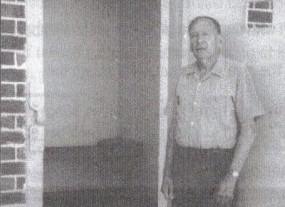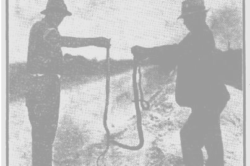Alan Leonard Remembers

Image credit: Community News
Locked in the Police Cells at Henley Beach
It was every child’s nightmare – being locked in the dark in a prison cell. This familiar, if vague threat, came true for AIan Leonard, when aged 5, he found the cell door of the Henley Beach lock up closing behind him.
Although 85 (in 1995) , Mr Leonard clearly remembers the incident, a colourful example of another time and way of life. He was a frequent visitor to the detached cells behind the old police station in Military Rd, as his grandfather lived next door and often quietly passed cups of coffee to those “drying out” in the cells overnight. While young Alan was peering into the cell with its wooden bed complete with wooden pillow, the door unexpectedly shut fast behind him. Perhaps there was method in this ploy of his grandfather’s, for Alan was never to find himself locked in again, unofficially or otherwise.
These memories came back when Mr Leonard was inspecting the conservation work which has been completed on the disused cells. The Heritage Conservation Project has been carried out by a small group of long-term unemployed people on a work experience and training placement through the “New Work Opportunities” Program. This program is funded by the Federal Department of Employment, Education and Training. The area around the two cells was landscaped and irrigated, brick paving laid, brickwork cleaned and repointed, doors rebuilt, and old-style locks installed.
Mr Leonard said he was pleased to see this aspect of the heritage of the Henley Beach area where he has lived all his life, being retained and conserved.
(Source: Community News, Feb-March 1995)
The history of the gramophone
Alan and Nell Leonard spoke at the May 1997 meeting of the Society. Alan spoke on the history of the gramophone (phonograph). He still retains, in his retirement, three phonographs from his once comprehensive collection, and these he demonstrated, with most interesting old recordings. Nell told the story of the dog featured in the famous His Masters Voice advertisement.
From Alan’s notes:
Thomas Edison and Graham Bell were experimenting with two containers similar to jam tins, with cord fastened at both ends. They pulled the cord tight and spoke to each other. Edison, who was slightly deaf through accident, could not hear Bell, but Bell could hear Edison.
When the bottom of the can was touched, slight vibrations could be felt, and Edison said that, if the vibrations could be reproduced, he could make a talking machine – and he succeeded in doing this.
At first the machine was not meant for entertaining; it was only an experiment. But Edison, with insight, soon foresaw uses and developments, such as : talking ‘books’ for the blind, teaching of elocution and foreign languages, preservation of the words of family members and the speeches of the Washingtons, Lincolns and Gladstones of the future, storage of music.
The cylinder machine was first demonstrated at Edison’s Menlo Park Laboratory. People had heard about it, and came from near and far.
The machine was placed on a large box as Edison turned the handle, spoke into it, and then back came his rendition of ‘Mary had a little lamb’. A Bishop who was present – Bishop John Vincent – said he didn’t believe it was true – someone must be in the box repeating the words. Edison invited the Bishop to speak into the machine. He did so and, as Edison continued working the primitive phonograph,, the Bishop heard, to his amazement, his own voice reproduced.
Edison was no longer a fake, but the Wizard and Genius of Menlo Park! The phonograph playing vinyl discs, of course, replaced the early models which used cylinders.
(abridged article from H&GHS Journal 18 1997)
Early Entertainment in Henley
Silent pictures were shown in Belcher’s Kiosk (where Moby Dicks was) every Saturday afternoon and some Sunday nights. One of the serials was called ‘The Hooded Terror’. You remember the old serials – someone was always tied to the train-line, and off would go the camera. We all had to come back next week, to see the hero next week in time to rescue his girlfriend.
There were open-air pictures where the Savings Bank was (editor note: which is now the northern side of the Seaview Road carpark). Deck chairs were put out in a paddock of soft sand. You just walked in and paid your money, and even the aisle was soft sand. People would bring their dogs and sit them down alongside the chairs. The Johns family, who owned the butcher’s shop, always came along with their big dog – a shaggy sheep dog.
The Town Hall was built in 1921. I can remember, as a boy of about 11 years old, playing in there and being told by the workmen to move out. I was attracted to buildings and used to like to go and see how they were built. Pictures were held in the Town Hall on Saturday afternoon and night and on Wednesday night. The pianist was Dorothy Angus, who was a music teacher and lived in Sussex Street. She was a master on the piano. If there was a horse-race, she’d play from the ‘William Tell Overture’, going for her life. If there was something very solemn, she’d play from the ‘Poet and Peasant’. Without any music, she’d change, as quick as a flash, as scenes changed in the film.
In 1934, a cement skating rink was set up where the new Post Office on the Esplanade was (editor note: just south of the Ramsgate Hotel), and it ran for several years. People paid sixpence to go and watch and a shilling to skate, including the skates.
After that went flat, midget golf took over. Midget golf was everywhere. We had three in the Beach – next to where the new Post Office was, almost next to the Ramsgate; on top of the Pier Cafe, which has been demolished and at the back of the Pier Cafe. (The Pier Cafe was next the old Billiard Saloon, which is itself is a Café now. (editor note Stellas Café 2023).
(abridged from the article in H&GHS Journal 4 1983)
Henley’s Snake Man
An interesting character in Henley was snake-charmer Joe Murray.

Image credit: Henley & Grange Historical Society
He was short, limped a little, and was rather eccentric. He used to go to the sandhills, and catch death adders and red-bellied snakes, and bring them back in a bag. When he put them down by the jetty, people would throw him money, and he would go and pick the snakes up. And I’ve been told that many a time he took the bag of snakes into the hotel and cleared the floor by bringing them out – he loved giving people a scare.
He often had four snakes twined around his neck and another in his hand and was often bitten. He used brandy as an antidote to some bites but always carried his own medicine made from native herbs and it never failed him. Once, he used two mirrors to treat a bite on his back and once took a bite on his tongue. He would lance the wound, suck the affected spot, then put his lotion into the wound to burn out the remaining poison.
There were a lot of death adders in the South Henley sandhills, and we were always warned to be wary of these short but very deadly snakes.’
(abridged from an article in H&GHS Journal 16, 1995)
0 Comments